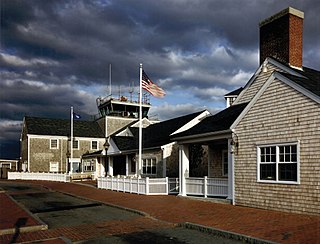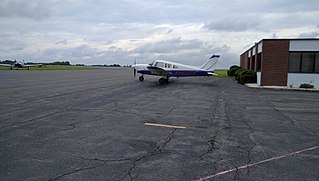Related Research Articles
Mesaba Aviation, Inc. was a regional airline in the United States that operated from 1944 until it merged with Pinnacle Airlines in 2012 to form Endeavor Air. It was based in Eagan, Minnesota From 2010 to 2012, the airline was a wholly owned subsidiary of Pinnacle Airlines Corp. with code sharing flights operated as Delta Connection for Delta Air Lines and US Airways Express for US Airways. Previously, the airline operated code sharing service as Northwest Airlink and Northwest Jetlink on behalf of Northwest Airlines which subsequently merged with Delta. Mesaba also previously operated connecting flight services in association with Republic Airlines before this air carrier was subsequently merged into Northwest. Mesaba Airlines effectively ceased operations on January 4, 2012, when all aircraft and personnel were transitioned to the Pinnacle Airlines operating certificate. Mesaba's operating certificate was surrendered on July 31, 2012.

Richmond International Airport is a joint civil-military airport in Sandston, Virginia, United States, an unincorporated community. The airport is about 7 miles (11 km) southeast of downtown Richmond, the capital of the Commonwealth of Virginia. Richmond International Airport is the busiest airport in central Virginia and the third-busiest in the state behind Washington Reagan and Washington Dulles. RIC covers 2,500 acres of land.
US Airways Express was the brand name for the regional affiliate of US Airways, under which a number of individually owned commuter air carriers and regional airlines operate short and medium haul routes. This code sharing service was previously operated as USAir Express. Mainline carriers often outsource to regional airlines to operate services in order to increase frequency, serve routes that would not sustain larger aircraft, or for other competitive reasons. US Airways Express operations were conducted from smaller markets in the United States, Canada, and the Bahamas primarily centered on US Airways' major hubs and focus cities.

Air Midwest, Inc., was a Federal Aviation Administration Part 121 certificated air carrier that operated under air carrier certificate number AMWA510A issued on May 15, 1965. It was headquartered in Wichita, Kansas, United States, and from 1991 was a subsidiary of Mesa Air Group. Besides initially flying as an independent air carrier, it later operated code sharing feeder flights on behalf of Eastern Air Lines as Eastern Air Midwest Express, on behalf of American Airlines as American Eagle, on behalf of Trans World Airlines (TWA) as Trans World Express and on behalf of US Airways as US Airways Express. It also operated feeder flights on behalf of Braniff (1983–1990) and Ozark Air Lines in addition to flying for Mesa Airlines. Air Midwest was shut down by its parent company, Mesa Airlines, in June 2008.

Grand Canyon National Park Airport is a state-owned public-use airport located in Tusayan, CDP in unincorporated Coconino County, Arizona, United States. It is near Grand Canyon National Park, 1 mile from the South Rim entrance of the Grand Canyon. The airport is primarily used for scenic tours and charter flights.

Kinston Regional Jetport, also known as Stallings Field, is a public airport located three miles (5 km) northwest of the central business district of Kinston, a city in Lenoir County, North Carolina. The airport has a single runway that is one of the longest in the southeastern United States. It is mostly used for general aviation.

Nantucket Memorial Airport is a public airport on the south side of the island of Nantucket, Massachusetts, United States. It is owned by the Town of Nantucket and is located three miles (5 km) southeast of the town center. It is the second-busiest airport in the state, after Logan International Airport, due to intense corporate travel to and from the island in the high season.

Daytona Beach International Airport is a county-owned airport located three miles (5 km) southwest of Daytona Beach, next to Daytona International Speedway, in Volusia County, Florida, United States. The airport has 3 runways, a six-gate domestic terminal, and an international terminal. Daytona Beach is the headquarters of Embry-Riddle Aeronautical University.

Victoria Regional Airport is a county-owned, public-use airport located five nautical miles northeast of the central business district of Victoria, a city in Victoria County, Texas, United States. It is mostly used for military and general aviation, but is also served by one commercial airline with this scheduled passenger service being subsidized by the federal Essential Air Service (EAS) program.

Smith Reynolds Airport is a public airport 3 miles (5 km) northeast of Winston-Salem in Forsyth County, North Carolina. The airport has two runways, and is used for general aviation and flight training. There are currently no scheduled passenger airline flights. Smith Reynolds was once home to the Winston-Salem air show, usually held in September, which drew about 20,000 spectators. There has not been an airshow since 2015. The airport has multiple flight schools and maintenance facilities. Smith Reynolds also has an operational control tower that operates from 6:00 AM to 9:30 PM year-round. INT covers 702 acres of land.

Midway Airlines was a United States airline based in Morrisville, North Carolina, between Raleigh and Durham. The airline operated between 1993 and 2003.

The Florida Keys Marathon International Airport is a public airport located along the Overseas Highway (US1) in Marathon, in Monroe County, Florida, United States. The airport covers 197 acres (80 ha) and has one runway.

Mammoth Yosemite Airport is a town-owned public airport seven miles east of Mammoth Lakes, in Mono County, California, United States. Also known as Mammoth Lakes Airport or Mammoth–June Lake Airport, it is mainly used for general aviation, but has scheduled passenger flights operated by one airline which primarily serves the airport on a seasonal basis during the winter ski season. Additional scheduled passenger service for the Mammoth area is seasonally available at the nearby Eastern Sierra Regional Airport located in Bishop, CA.

On the surface, Wright Air Lines was no different than many other many other small turboprop airlines that collapsed in the early years of the deregulated US airline industry. What set Wright apart was:
Michael J. Smith Field is a public airport located one mile (2 km) north of the central business district of Beaufort and northeast of Morehead City, in Carteret County, North Carolina, United States. It is owned by the Beaufort-Morehead City Airport Authority.

Britt Airways was a regional airline in the United States that operated from 1964 until it merged with ExpressJet in 1996. It was established as Vercoa Air Service in 1964 and renamed to Britt Airlines when it was purchased by William and Marilyn Britt in 1975 later on Britt Airways. It was based in Terre Haute, Indiana until 1996. It began as a commuter airline. It primarily operated turboprop aircraft but also flew British Aircraft Corporation BAC One-Eleven twinjets as an independent air carrier at one point as well. The airline evolved into a regional air carrier operating code share flights primarily for Continental Airlines.
Wings West Airlines was an American regional airline headquartered at McChesney Field (SBP), unincorporated San Luis Obispo County, California. The airline initially began scheduled passenger service as an independent commuter air carrier and then subsequently became an American Eagle affiliate of American Airlines operating turboprop aircraft on code sharing flights on behalf of American.

Altair Airlines was an airline based in Philadelphia. It was in service from 1967 to 1982. According to its June 15, 1982 system timetable, the Altair name was taken from the first magnitude star "Altairius" brightest in the constellation "Aquila" (Eagle) from which the airline's Blue Eagle symbol was derived.

Metro Airlines, originally Houston Metro Airlines, was a commuter airline that was originally headquartered in Houston, Texas, United States. Metro subsequently moved its headquarters to north Texas. The airline had an operational base located on the grounds of Dallas/Fort Worth International Airport and also had offices on the airport property and in Grapevine, Texas. Metro evolved into an airline holding company with the acquisition or creation of a number of different airlines, including as the banner carrier operating feeder services for Eastern Airlines as Eastern Metro Express which was based in Atlanta, GA and Metroflight which operated American Eagle service from the Dallas/Ft. Worth Airport. The company filed for bankruptcy in 1993, and the assets were acquired by AMR Simmons Airlines.

Soldotna Airport is a city-owned, public use airport located one nautical mile (1.85 km) southeast of the central business district of Soldotna, Alaska.
References
- ↑ Gubert, Betty Kaplan; Sawyer, Miriam; Fannin, Caroline M. (2002). Distinguished African Americans in Aviation and Space Science. Greenwood Publishing Group. p. 290. ISBN 9781573562461.
- ↑ Davies, Ronald Edward George; Quastler, I. E. (1995). "Wheeler Airlines". Commuter Airlines of the United States. Smithsonian Institution Press. ISBN 9781560984047.
- ↑ "Wheeling Wheeler" . Time Magazine . Jul 21, 1975.
- ↑ February 1, 1976 Official Airline Guide (OAG)
- ↑ Wheeler airlines schedule. 1977, 1978, 1983 and 1984.
- ↑ Weston, Martin (April 1976). "First Black Airline Gets Off The Ground". Ebony . Retrieved 29 September 2018.
- ↑ "Black woman pilot". Ebony Magazine . April 1991.
- ↑ "Increasing PT-6 Hot Section Life". Aviation Mechanics Journal. January 1982.
- ↑ "Wheeler Airlines—An American First". Tar Heel Junior Historian. North Carolina Museum of History. Fall 2003.
- ↑ http://www.departedflights.com, Wheeler Airlines route maps, April 15, 1975 through Nov. 1, 1986